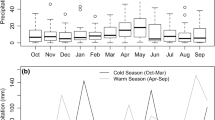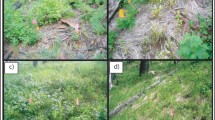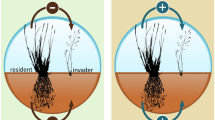Abstract
Novel grasslands embedded in anthropogenic landscapes are increasingly threatened due to invasion by exotic woody species. This potential for tree invasion in grasslands can be either facilitated or hindered by disturbance agents and/or herbaceous composition. Furthermore, disturbances may depend on inter-annual rainfall modifying the chance of woody establishment. Here we determine how large- and small-scale disturbances influence the establishment of the exotic tree Gleditsia triacanthos across different herbaceous patches in an old-field pampa grassland in Argentina. Tree seeds were copiously added in all study plots and were then monitored over 4 years for seedling recruitment and growth rates in a fully factorial disturbance x patch type experimental design. We used burning (large scale) and armadillo-like burrowing (small scale) as the two levels of disturbance, and grass dominated and forb dominated patches as the two types of patches. After seed sowing, two seedling cohorts emerged during the drier and wetter summers, in March 2000 (xeric cohort) and January 2001(mesic cohort), respectively. Tree recruitment was twice as high for the mesic cohort in comparison to the xeric cohort, but for both cohorts tree recruitment was significantly higher in the forb patches than in the grass patches. For the mesic cohort, tree recruitment was enhanced for both types of disturbance, while for the xeric cohort, recruitment was depressed by the small-scale disturbance. Lastly, sapling growth rates were influenced by disturbance, with xeric cohort saplings being larger in the small-scale disturbance and mesic cohort saplings being smaller in the large-scale disturbance. Taken together, tree seedling invasion was enhanced in forb-dominated patches during an early dry season, but it was mainly enhanced by disturbance agents during a wetter season. Hence, while disturbances can promote exotic plant species, our findings emphasize the spatiotemporal aspects of woody invasions in novel grasslands.



Similar content being viewed by others
References
Abba AM, Zufiaurre E, Codesido M, Bilenca DM (2015) Burrowing activity by armadillos in agroecosystems of central Argentina: biogeography, land use, and rainfall effects. Agric Ecosys Environ 200:54–61
Alpert P, Bone E, Holzapfel C (2000) Invasiveness, invasibility and the role of environmental stress in the spread of non-native plants. Perspect Plant Ecol Evol Syst 3:52–66
Anadón JD, Sala OE, Turner BL, Bennett EM (2014) Effect of woody-plant encroachment on livestock production in North and South America. Proc Nat Acad Sci USA 111:12948–12953
Asner GP, Elmore AJ, Olander LP, Martin RE, Harris AT (2004) Grazing systems, ecosystem responses, and global change. Ann Rev Environ Res 29:261–299
Baldi G, Guerschman JP, Paruelo JM (2006) Characterizing fragmentation in temperate South America grasslands. Agric Ecosys Environ 116:197–208
Bond WJ (2008) What limits trees in C4 grasslands and savannas? Ann Rev Ecol Evol Syst 39:641–659
Brooks ML, D’Antonio CM, Richardson DM, Grace JB, Keeley JE, DiTomaso JM, Hobbs RJ, Pellant M, Pyke D (2004) Effects of invasive alien plants on fire regimes. Bioscience 54:677–688
Burkart SE, León RJ, Conde MC, Perelman SB (2011) Plant species diversity in remnant grasslands on arable soils in the cropping Pampa. Plant Ecol 212:1009–1024
Burton PJ, Bazzaz FA (1991) Tree seedling emergence on interactive temperature and moisture gradients and in patches of old-field vegetation. Am J Bot 78:131–149
Busch M, Knight C, Mazía N, Hodara K, Muschetto E, Chaneton EJ (2012) Rodent seed predation on tree invader species in grassland habitats of the Inland Pampa. Ecol Res 27:369–376
Chaneton EJ, Mazía CN, Machera M, Uchitel A, Ghersa CM (2004) Establishment of honey locust (Gleditsia triacanthos) in burned pampean grasslands. Weed Techn 18:1325–1329
Chaneton EJ, Mazía N, Batista WB, Rolhauser AG, Ghersa CM (2012) Woody plant invasions in Pampa grasslands: a biogeographical and community assembly perspective. In: Myster RW (ed) Ecotones between forest and grassland. Springer, Berlin, pp 115–144
Chapin FS III, Zavaleta ES, Eviner VT, Naylor RL, Vitousek PM, Reynolds HL, Hooper DU, Lavorel S, Sala OE, Hobbie SE, Mack MC, Díaz S (2000) Consequences of changing biodiversity. Nature 405:234–242
Cramer VA, Hobbs RJ, Standish RJ (2008) What’s new about old fields? Land abandonment and ecosystem assembly. Trends Ecol Evol 23:104–112
D’Antonio CM, Dudley TL, Mack M (1999) Disturbance and biological invasions: direct effects and feedbacks. In: Walker LR (ed) Ecosystems of disturbed ground, vol 16. Ecosystems of the world. Elsevier, Amsterdam, pp 413–452
Davis MA, Wrage KJ, Reich PB (1998) Competition between tree seedlings and herbaceous vegetation: support for a theory of resource supply and demand. J Ecol 86:652–661
Davis MA, Grime JP, Thompson K (2000) Fluctuating resources in plant communities: a general theory of invasibility. J Ecol 88:528–534
Davis MA, Bier L, Bushelle E, Diegel C, Johnson A, Kujala B (2005) Non-indigenous grasses impede woody succession. Plant Ecol 178:249–264
Dickie IA, Schnitzer SA, Reich PB, Hobbie SE (2007) Is oak establishment in old-fields and savanna openings context dependent? J Ecol 95:309–320
Facelli JM, León RJC (1986) El establecimiento espontáneo de árboles en la Pampa—Un enfoque experimental. Phytocoenol 14:263–274
Facelli JM, Montero CM, León RJC (1988) Effect of different disturbance regimen on seminatural grasslands of the subhumid pampa. Flora 180:241–249
February EC, Higgins SI, Bond WJ, Swemmer L (2013) Influence on competition and rainfall manipulation on the growth responses of savannas trees and grasses. Ecology 94:1155–1164
Fernandez RD, Ceballos SJ, Malizia A, Aragón R (2017) Gleditsia triacanthos (Fabaceae) in Argentina: a review of its invasión. Austr J Bot 65:203–213
Ferreras AE, Funes G, Galetto L (2015) The role of seed germination in the invasion process of Honey locust (Gleditsia triacanthos L., Fabaceae): comparison with a native confamilial. Plant Species Biol 30:126–136
Foley JA, DeFries R, Asner GP, Barford C, Bonan G, Carpenter SR, Chapin FS, Coe MT, Daily GC, Gibbs HK, Helkowski JH, Holloway T, Howard EA, Kucharik CJ, Monfreda C, Patz JA, Prentice IC, Ramankutty N, Snyder PK (2005) Global consequences of land use. Science 309:570–574
Funk JL, Cleland EE, Suding KN, Zavaleta ES (2008) Restoration through reassembly: plant traits and invasión resistance. Trends Ecol Evol 23:695–703
Ghersa CM, de la Fuente E, Suarez S, León RJC (2002) Woody species invasion in the Rolling Pampa grasslands, Argentina. Agric Ecosys Environ 88:271–278
Giorgis MA, Tecco PA, Cingolani AM, Renison D, Marcora P, Paiaro V (2011) Factors associated with woody alien species distribution in a newly invaded mountain system of central Argentina. Biol Inv 13:1423–1434
Goldstein L, Suding K (2014) Applying competition theory to invasion: resource impacts indicate invasion mechanisms in California shrub lands. Biol Inv 16:191–203
Hobbs RJ, Huenneke LF (1992) Disturbance, diversity, and invasion—implications for conservation. Cons Biol 6:324–337
Hobbs RJ, Arico S, Aronson J, Baron JS, Bridgewater P, Cramer VA, Epstein PR, Ewel JJ, Klink CA, Lugo AE, Norton D, Ojima D, Richardson DM, Sanderson EW, Valladares F, Vilà M, Zamora R, Zobel M (2006) Novel ecosystems: theoretical and management aspects of the new ecological world order. Global Ecol Biog 15:1–7
Hobbs RJ, Higgs E, Harris JA (2009) Novel ecosystems: implications for conservation and restoration. Trends Ecol Evol 24:599–605
King K, Cary GJ, Bradstock RA, Mardsen-Smedley JB (2013) Contrasting fire responses to climate and management: insights from two Australian ecosystems. Global Change Biol 19:1223–1235
Koerner SE, Avolio ML, Chang CC, Gray J, Hoover DL, Smith MD (2015) Invasibility of a mesic grassland depends on the time-scale of fluctuating resources. J Ecol 103:1538–1546
Lamarque JL, Delzon S, Lortie CJ (2011) Tree invasions: a comparative test of the dominant hypotheses and functional traits. Biol Inv 13:1969–1989
Laterra P, Vignolo OR, Linares MP, Giaquinta A, Maceira N (2003) Cumulative effects of fire on tussock pampa grasslands. J Veg Sci 14:43–54
Lockwood J, Hoopes MF, Marchetti MP (2007) Invasion Ecology. Blackwell, Oxford
Machera M (2006) La invasión de pastizales por especies exóticas: el papel de disturbios de diferente escala espacial. PhD Dissertation, Facultad de Ciencias Exactas y Naturales, University of Buenos Aires, Argentina
Marco DE, Páez SA (2000) Invasion of Gleditsia triacanthos in Lithraea ternifolia forests of central Argentina. Environ Manag 26:409–419
Mazía CN, Chaneton EJ, Ghersa CM, León RJC (2001) Limits to tree species invasion in pampean grassland and forest plant communities. Oecologia 128:594–602
Mazía CN, Chaneton EJ, Machera M, Uchitel A, Feler MV, Ghersa CM (2010) Antagonistic effects of large- and small-scale disturbances on exotic tree invasion in a native tussock grassland relict. Biol Inv 12:3109–3122
Mazía N, Tognetti PM, Cirino ED (2013) Patch identity and the spatial heterogeneity of woody encroachment in exotic dominated old-field grasslands. Plant Ecol 214:267–277
Melbourne BA, Cornell HV, Davies KF, Dugaw CJ, Elmendorf S, Freestone AL, Hall RJ, Harrison S, Hastings A, Holland M, Holyoak M, Lambrinos J, Moore K, Yokomizo H (2007) Invasion in a heterogeneous world: resistance, coexistence or hostile takeover? Ecol Lett 10:77–94
Miranda MI (2010) Cambios inducidos por la invasión de árboles en la estructura y el funcionamiento de pastizales sucesionales. PhD Dissertation, Facultad de Agronomía, Universidad de Buenos Aires, Argentina
Parodi LR (1942) ¿Por qué no existen bosques naturales en la llanura bonariense si los árboles crecen en ella cuando se los cultiva? Rev Centr Estud Agron 30:387–390
Parodi LR (1947) La estepa pampeana. In: Hauman L, Burkart AE, Parodi LR, Cabrera AL (eds) La vegetación de la Argentina. GAEA Geografía de la República Argentina, Buenos Aires, pp 143–207
Poggio SL, Chaneton EJ, Ghersa CM (2010) Landscape complexity differentially affects alpha, beta, and gamma diversity of plants occurring in fencerows and crop fields. Biol Conserv 143:2477–2486
Prieto AR (1996) Late Quaternary vegetational and climatic changes in the Pampa grassland of Argentina. Quart Res 45:73–88
Prieto AR, Blasi AM, De Francesco CG, Fernández C (2004) Environmental history since 11,000 14 C yr BP of the northeastern Pampas, Argentina, from alluvial sequences of the Luján River. Quart Res 62:146–161
Pyŝek P, Jaroseik V, Hulme PE, Pergl J, Hejda M, Urs Schaffner, Vilá M (2012) A global assessment of invasive plant impacts on resident species, communities and ecosystems: the interaction of impact measures, invading species’ traits and environment. Global Change Biol 18:1725–1737
Richardson DM, Gaertner M (2013) Plant invasions as builders and shapers of novel ecosystems. In: Hobbs RJ, Higgs ES, Hall CM (eds) Novel Ecosystems. Intervening in the New Ecological World Order. Wiley, New York, pp 102–113
Richardson DM, Rejmánek M (2011) Trees and shrubs as invasive alien species—a global review. Div Dist 17:788–809
Rundel PW, Dickie I, Richardson DM (2014) Tree invasions into treeless areas: mechanisms and ecosystem processes. Biol Inv 16:663–675
Sabiti EN, Wein RW (1987) Fire and Acacia seeds: a hypothesis of colonization succes. J Ecol 74:937–946
Sankaran M, Hanan NP, Scholes RJ (2005) Determinants of woody cover in African savannas. Nature 438:846–849
Schnabel A, Wendel JF (1998) Cladistic biogeography of Gleditsia (Leguminosae) based on NDHF and RPL16 chloroplast gene sequences. Am J Bot 85:1753–1765
Schuster MJ, Dukes JS (2017) Rainfall variability counteracts N addition by promoting invasive Lonicera maackii and extending phenology in prairie. Ecol Appl 27:1555–1563
Shea K, Chesson PS (2002) Community ecology theory as a framework for biological invasions. Trends Ecol Evol 17:170–176
Simberloff D (2011) How common are invasion-induced ecosystem impacts? Biol Inv 13:1255–1268
Simberloff D, Nuñez MA, Ledgard NJ, Pauchard A, Richardson DM, Sarasola M, Van Wilgen B, Zalba SM, Zenni RD, Bustamente R, Peña E, Ziller SR (2010) Spread and impact of introduced conifers in South America: lessons from other southern hemisphere regions. Austral Ecol 35:489–504
Smit C, Den Ouden JAN, Müller-Schärer HEINZ (2006) Unpalatable plants facilitate tree sapling survival in wooded pastures. J Appl Ecol 43:305–312
StatSoft Inc. (1999) STATISTICA for Windows. Computer program manual. StatSoft, Tulsa
Tognetti PM, Chaneton EJ, Trebino HJ, Omacini M, León RJC (2010) Exotic versus native plant dominance over 20 years of old-field succession on set-aside farmland in Argentina. Biol Conserv 143:2494–2503
Tonello MS, Prieto AR (2008) Modern vegetation–pollen–climate relationships for the Pampa grasslands of Argentina. J Biogeogr 35:926–938
Vega E, Baldi G, Jobbagy EG, Paruelo JM (2009) Land use change patterns in the Río de la Plata grasslands: the influence of phytogeographic and political boundaries. Agric Ecosys Envir 134:287–292
Vilá M, Espinar JL, Hejda M, Hulme PE, Jarošik V, Maron JL, Pergl J, Schaffner U, Sun Y, Pyšek P (2011) Ecological impacts of invasive alien plants: a meta-analysis of their effects on species, communities and ecosystems. Ecol Lett 14:702–708
Von Holle B, Simberloff D (2005) Ecological resistance to biological invasion overwhelmed by propagule pressure. Ecology 86:3212–3218
Wakeling JL, Cramer MD, Bond WJ (2012) The savanna-grassland ‘treeline’: why don’t savanna trees occur in upland grasslands? J Ecol 100:381–391
Zalba SM, Villamil CB (2002) Woody plant invasion in relictual grasslands. Biol Inv 4:55–72
Zar J (1999) Biostatistical analysis, 4th edn. Prentice Hall, Upper Saddle River
Acknowledgements
We thank M. Machera, V. Feller, A. Uchitel, M. L. Bolkovic, H. Trebino, P. Tognetti, M. Rabadán and D. Ferraro for field assistance, and the staff at Estancia “San Claudio” and Administración de Campos (UBA) for logistical support. We are also very grateful for the work done by two reviewers who helped to improve the manuscript. The study was funded by Agencia Nacional de Promoción Científica y Tecnológica (FONCYT), Consejo Nacional de Investigaciones Científicas y Técnicas (CONICET), and Universidad de Buenos Aires.
Author information
Authors and Affiliations
Corresponding author
Rights and permissions
About this article
Cite this article
Mazía, N., Chaneton, E.J. & Ghersa, C.M. Disturbance types, herbaceous composition, and rainfall season determine exotic tree invasion in novel grassland. Biol Invasions 21, 1351–1363 (2019). https://doi.org/10.1007/s10530-018-1906-x
Received:
Accepted:
Published:
Issue Date:
DOI: https://doi.org/10.1007/s10530-018-1906-x




